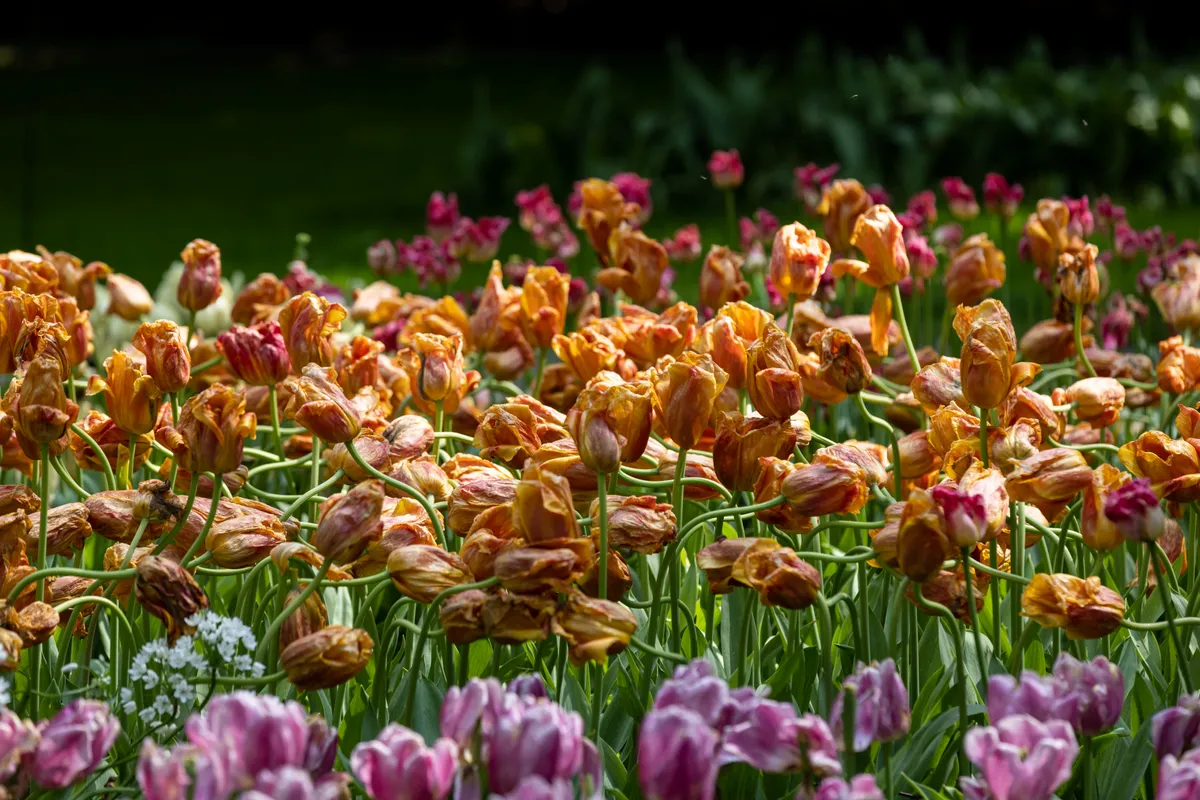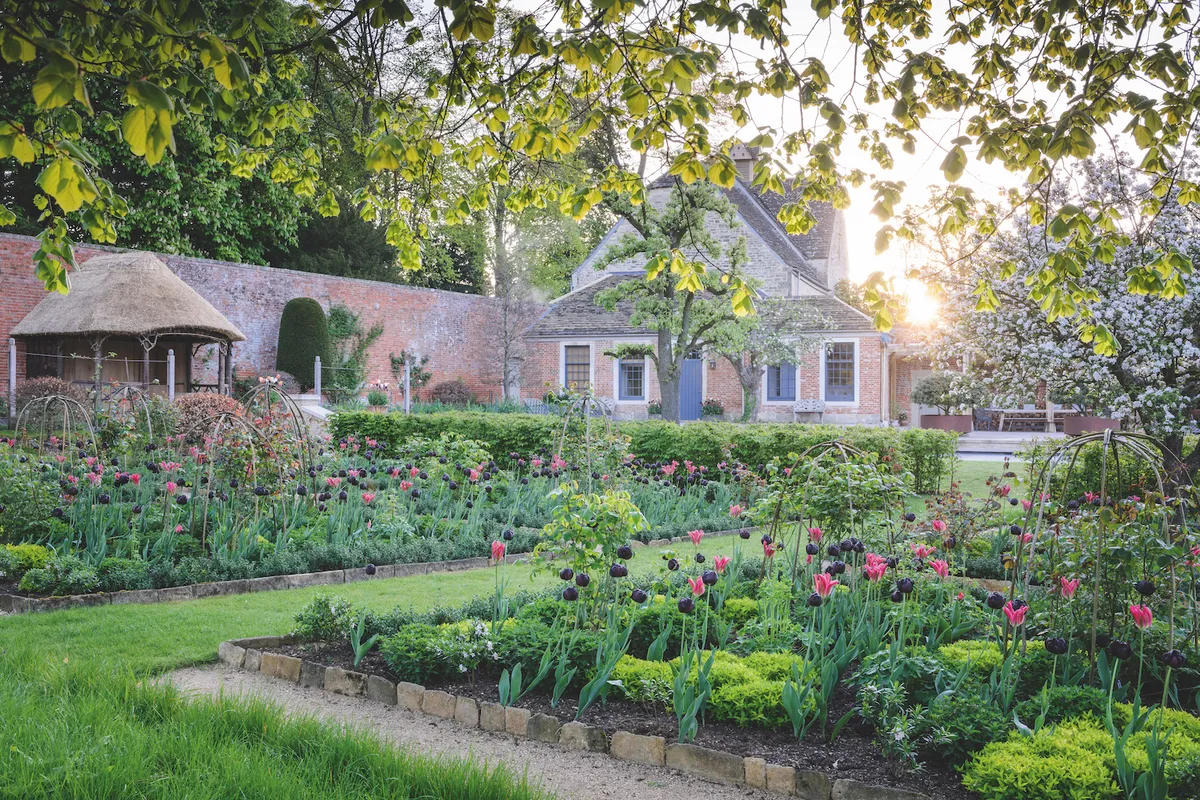When your tulips start coming up in the garden, or when you're planting bulbs in autumn, it’s important to check them for sigs of tulip fire. Here's what to look out for, plus advice on avoiding the disease.
Jump to
What is tulip fire?
Tulip fire is a fungal disease, Botrytis tulipae, that affects tulips. Tulip fire causes brown holes in leaves and distorted growth. It is so-called as in bad cases, the foliage can look as if it has been scorched. You may also see fuzzy grey mould around the dead areas of foliage and black fungal spores on the bulbs themselves. It is often particularly prevalent in warm, wet springs. The spores of tulip fire can persist in soil for several years and can also be carried on the bulbs themselves.
More on tulips
- 21 of the best tulips from Belcombe Court
- How to grow tulips
- How to grow species tulips
- Tulip fire: should we be worried?
- How to keep squirrels off your tulip bulbs
Some gardens no longer feature tulips, having been badly affected by the disease. Sissinghurst Castle Garden in Kent, for example, no longer has tulip displays in spring, following an outbreak of tulip fire around the garden in 2023. Head gardener Troy Scott Smith and his team dug up all infected tulip bulbs in the garden, including some species tulip varieties and will not be planting more for several years.
What does tulip fire look like?

The leaves have small holes in them, and you may see burn-like marks on the petals.
The foliage may also appear twisted and gnarled.
There may also be black sclerotia (small black lumps) on the bulbs.
What to do if you spot tulip fire

If you spot the signs, act quickly so that the disease doesn’t spread.
- Using a spade or a long trowel, remove the infected bulb from the soil, and bin it – don’t add to it to the compost bin.
- Also gather up any fallen petals
- Disinfect your tools to prevent the disease spreading.
- Do not plant bulbs in the same area of ground for at least three years, as the spores can persist in the soil.
Bear in mind that tulip fire can also be confused with other tulip problems, such as grey mould.
How to treat tulip fire
There is no current treatment available for tulip fire - prevention is better than cure.
How to avoid tulip fire

Buy bulbs from a reputable supplier
"Commercial growers have a wide range of fungicides to control tulip fire, including some acceptable for organic regimes," explains Guy Barter, chief horticulturalist at the RHS.
In autumn, check the bulbs over for signs of the black fungus spores.
Give them the right conditions
Check that you have the right conditions for growing tulips - they grow best in a sunny spot, in well drained soil. Plantswoman and bulb expert Jacqueline de Kloet points out that tulips are demanding bulbs. "They need perfect circumstances to be able to perform well. They should be planted in November when the soil has cooled down a bit, they should be planted deep ( at least at 15 cm depth) in a well-drained, not too poor soil in a sunny spot. They need lots of sunlight and warmth. And they are greedy, so I use organic fertiliser when they start to grow, in February-March."
Plant bulbs further apart
Plant tulips in borders less densely, so they are less likely to infect each other. “To prevent tulip fire I recommend planting the tulips a little further apart than normal, to allow air circulation and to prevent diseased parts of one tulip from touching another," advises expert tulip and cut flower grower Polly Nicholson.
Rotate your tulips

Many gardens rotate the areas where they grow tulips, so that disease does not build up in the soil. Polly Nicholson operates a four-year rotation in her cut flower field. "A bed which has been planted with tulips for cutting remains tulip-free for three years, to allow any pathogens lurking in the soil to dissipate.”
"A high fungal risk arises if you plant tulips in the same soil for several years," explains Carien van Boxtel. "Tulip residues left behind in and on top of the soil are affected by Botrytis during the dying process. This fungus will remain in the soil via sclerotia (small black seed-like structures produced on the dead tissue) and can contaminate the soil but also the outer bulb scales. If the weather is reasonably dry in spring during the growing period, the fungus has little chance of spreading and infecting surrounding leaves and flowers. But during a wet spring chances are that your tulips will be affected."
“As we rotate our big display areas of tulips, we have managed to avoid any major incidents of tulip fire so far," says Arundel Castle's head gardener, Martin Duncan. “However at the first sign of any tulip fire we remove the whole bulb.”
Plant bulbs later in autumn
Plant tulips as late as possible in autumn, ideally in November after a frost – low temperatures can kill the fungal spores. Plant them as deep as possible - at least 15cm and up to 30cm.
Dig up your tulips, dry them over summer and replant the following autumn
"Always dig your hybrid tulips bulbs up and store them dry in summer," advises Carien van Boxtel. "There is no guarantee that they will perform as well as the first year, however. "Deadhead your tulips before digging them up and dispose of the petals." Do not leave petals on the soil.
Plant in pots

If you have been affected by tulip fire in your garden, it is still fine to plant fresh tulips in sterilised pots, in fresh potting compost. Growing tulips in sterilised pots, in fresh compost, means you can still enjoy visual impact around the garden, even if tulip fire has been an issue. Arundel Castle, which is known for its fabulous tulip displays, usually around 400 pots of them, in fresh organic potting compost with good drainage.
Grow in grass
Growing bulbs in grass also appears to lessen the risk of tulip fire. “We’ve had really good success with growing the species varieties in grass," says bulb expert Sarah Raven. "In grass, you don’t get the fungal spores spotting upwards as you do from soil. We had no tulip fire at all on various species varieties such as ‘Little Beauty’ or on the Tulipa clusiana types.”




